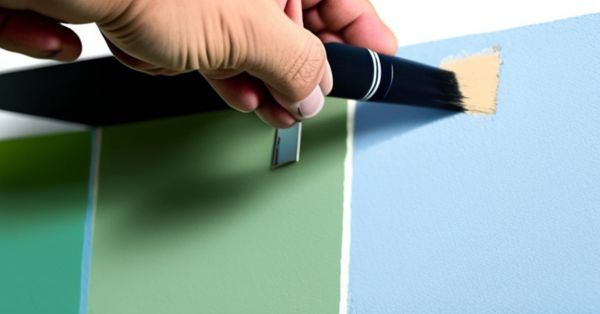Even if you have the best paint jobs, the walls will damage eventually. So, touching up surfaces and walls is just an integral part of home maintenance. But what about paint chips? If you are thinking about fixing paint chips on your wall, there is an easy, quick method.
Painting the whole wall is a matter of planning because you want your home to look great. However, you can fix paint chips without the need to paint the whole wall. So, how to fix paint chips on wall without paint? Continue reading the post to learn more about it.
Why do paint chips on walls?
Paint chips on your walls for several reasons. Elements such as extreme temperature and moisture are the most common reasons for paint chipping. Sometimes, it is the dust particles that get stuck on the walls and cause chipping after a certain period. To remove the paint chips use a putty knife and gently scrape them off before applying small touch-ups.
Materials that you will need to perform the task
There are a few methods that will help fix paint chips on your wall without painting the whole wall. You can use sandpaper or a putty knife to smoothen the edges surrounding the paint chips. Or, you can use a small paintbrush and paint right over the damaged area. Whatever method you choose, you need the right materials to undertake the task effectively. Following are the materials you will need for this purpose.
- Scrubbing brush
- Paper towel, sponge, rag
- Ammonia or bleach
- A bucket of water
- Damp rag to clean the damaged area
- Wet cloth or vacuum
Fixing paint chips on your wall the right way
Now that you know why paint chips on walls and you have got the materials that you need to fix the problem, follow the instructions below.
1. Make the cleaning solution
Before you start fixing the paint chips, it is important to clean the damaged area. To do that in the right way, you will need a solution that consists of ammonia or bleach along with water. The solution will help clean the walls. As such, any kind of dirt gets removed from that area.
2. Apply the solution
After the solution gets ready, pour it in small amounts into the scrubbing pot. The next step will be to brush the mixture on top of the paint chips that you want to fix. With the help of the scrub brush, proceed further. When you mix it around with the scrub brush, the solution will cover every area where you should apply the mix
3. Keep on doing the same
Repeat the step if there is a necessity. Besides, make sure that you do the same until all the paint disappears from the wall. Keep in mind that you shouldn’t leave the setting as it is for too long. Making the liquid sit for a prolonged period can increase the chances of damaging the walls.
4. Take off the extra moisture
As said, it is not good to keep the liquid sitting on your walls for a long. Therefore, to keep your walls from damage, clean off excess moisture from the area. Waiting for a few minutes before taking off the extra moisture is enough. Use a damp cloth or paper towel to remove the extra moisture. All you need to do is wipe gently and you are good to go.
5. Remove the leftovers
Next, you have to use a vacuum to remove dust that is left behind. The dust is the leftovers of the old paint. It is good to keep the area in that manner so that it can dry completely. Allow them to dry overnight or you can keep them for more hours.
6. Apply new coats
When you are done keeping the area dry overnight, it is time for you to apply fresh coats of paint. Don’t worry, you don’t have to paint the whole wall. Rather, you need to touch up certain areas of the walls with a new coat of paint that is damaged by the corrosive effects of ammonia and water.
Get more aesthetic painting ideas for beginners.
Precautions to take when fixing paint chips
- Keep in your mind never to use this method on specific areas of your wall that are susceptible to moisture. Don’t apply the method to other types of wall damage either.
- Don’t apply the method on walls near light fixtures, switches, or even electrical outlets in your home. That’s because they might get damaged due to exposure to water.
- If you have asthma or other kinds of respiratory conditions, it is better not to proceed with the method. The dangerous fumes could trigger an attack and make you feel uncomfortable.
- Never use this method on areas of the wall that you have painted recently. At least, wait for six months before attempting this method.
Frequently Asked Questions (FAQs)
What is the difference between touch-ups and repainting?
When the damage to your walls is small, a touch-up is your best bet. Flaws that aren’t visible can be resolved using a touch-up. But if you want to update the appearance of your home, repainting provides a long-lasting solution.
Is it good to paint over chipped paint?
No, you have to remove and clean the chipped area and follow it up with a touch-up of a fresh coat.
How do you remove the paint chips?
Scrape away the area with a putty knife. Clean up the remaining residue using steel wool or sandpaper. This will break them free from the surface.
Final Verdict
So, that was all about fixing paint chips on your walls without the need to paint the entire wall. You need a few common household items to make this project a hit. The best part about the solution mentioned above is that you can do it with ease.
Also, they are inexpensive as well. Therefore, the next time you have a few paint chips on your walls, don’t wait for long to get the whole painting done. Instead, consider the different ways to resolve the issue as mentioned above.






